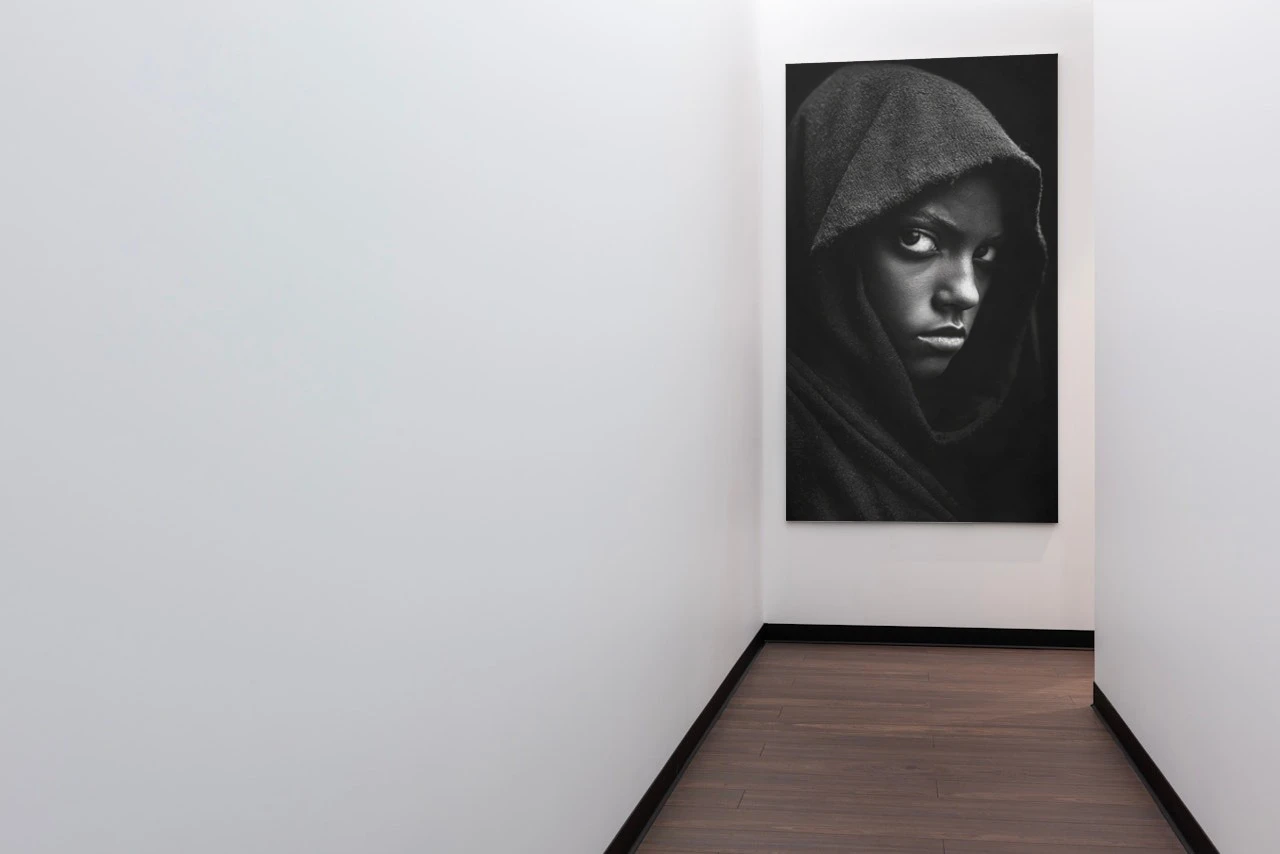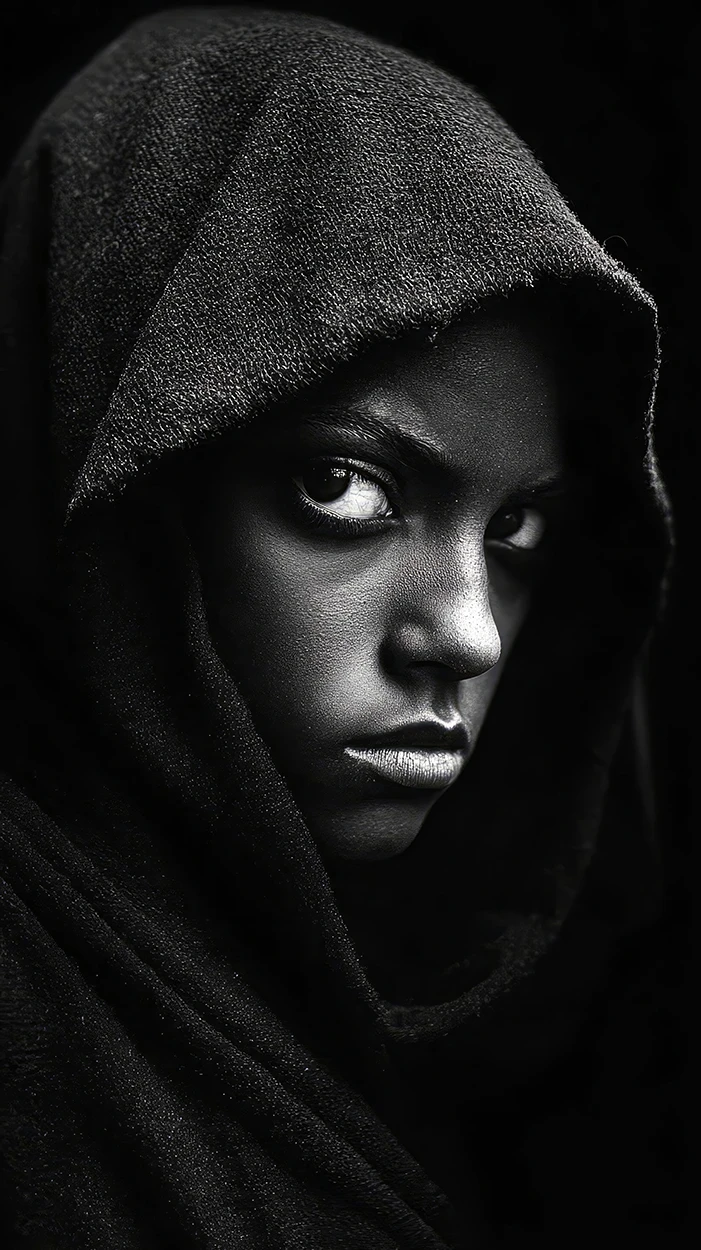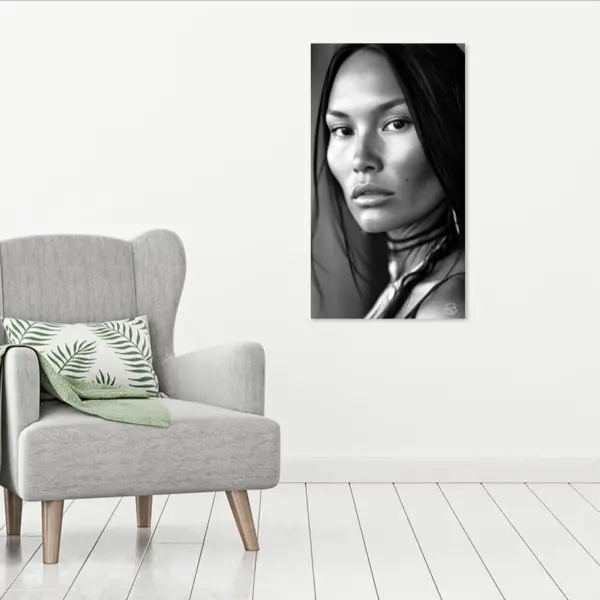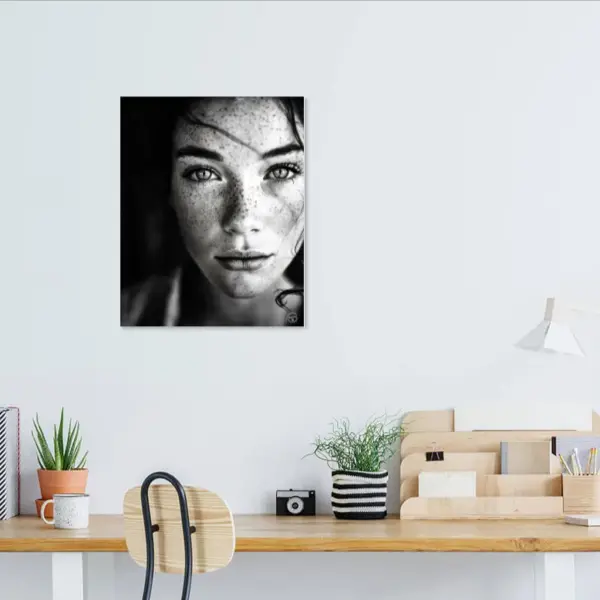Wild Desert Princess
In the haunting and evocative portrait titled “Wild Desert Princess,” the artist captures a profound intensity that leaps from the canvas. The subject, cloaked in deep, textured shadows, radiates an aura of resilience and quiet defiance. Her piercing gaze commands attention, her eyes filled with untold stories of struggle, survival, and an untamed spirit. The stark black-and-white contrast heightens the drama, emphasizing every detail of her expression and the fabric that frames her face.
The choice of monochrome strips away distractions, allowing the viewer to focus solely on the raw emotion conveyed. The textured hood, which wraps around her, suggests both protection and isolation. There’s a tactile quality to the fabric, almost as if the viewer could reach out and feel its rough texture—a reflection of the harsh desert life implied by the title.
This “princess” is not adorned with traditional symbols of royalty but instead carries a regal power through her sheer presence. The desert, a place often associated with desolation and extreme conditions, becomes a metaphor for her inner world. She is wild, untamed by societal expectations, yet dignified in her silence. The shadows that obscure part of her face add to the mystery, suggesting there are parts of her story we may never fully know.
The deliberate focus on her face, especially her penetrating eyes, creates an intimate connection between the viewer and the subject. It’s as if she is both watching us and challenging us to understand the depth of her experience. There’s no vulnerability in her expression—only strength forged in adversity. The artist masterfully balances light and darkness, using the interplay of shadows to accentuate the contours of her features and the rich emotional landscape they represent.
The title “Wild Desert Princess” feels perfectly fitting. She embodies the wild, a force of nature shaped by the unforgiving desert environment, yet with an undeniable grace and nobility that transcends her surroundings. The title invites us to consider not just the external desert but the internal one—the emotional, psychological terrain that this figure navigates.
In this portrait, the artist has created more than just an image; they’ve crafted a narrative, one that is as mysterious as it is compelling. The viewer is left with questions: What has she endured? What dreams or desires hide behind that stern exterior? And most importantly, what does she see in us as we stand before her? The “Wild Desert Princess” is not just a passive figure but an active participant in the exchange, drawing us into her world and demanding that we acknowledge her strength, her story, and her presence.
This work resonates with anyone who has ever felt like an outsider or faced struggles that are difficult to articulate. Through her, the artist speaks to the resilience of the human spirit, especially those who navigate life’s harshest landscapes with unwavering grace. The image lingers in the mind, a testament to the power of art to communicate beyond words, across cultures, and through time.
Looking to purchase art from our online gallery? Follow these simple steps:
- Find the artwork you love and click on it. If you're considering multiple pieces, click "ADD TO CART." If you've decided on just one, click "BUY NOW."
- Feel free to keep browsing our gallery and adding more artwork to your cart.
- To review your selected artworks, click on the shopping cart icon in the top right corner. You can remove any items if you change your mind.
- When you're ready to complete your order, click "CHECKOUT" at the top right corner of the screen.
- After your purchase, you'll receive a download link. Additionally, we'll send the link to your email address for easy access.
Wondering how to pay for your selected artworks? Here's how:
Simply click the "CHECKOUT" button to finalize your order, and then select your preferred payment method. We offer the following options:
- Credit cards (Stripe)
- PayPal
- Bank transfer (Upon placing your order, we'll send you an invoice. Once the invoice is paid in full, we'll proceed to ship the artwork.)
Is the payment secure?
- Rest assured, our payment system is highly secure. We exclusively process transactions that are 3D secured to combat fraud.
- Additionally, as an added measure of protection, we may request identity verification to prevent unauthorized use of your credit card.
Is it possible to request a commissioned artwork with specific size and color preferences?
- Interested in commissioning an artwork of a specific size or color? While not all artists offer commissions for paintings and sculptures, you can request a customized size print.
- Feel free to reach out to us and share your requirements if you're interested in commissioning an artwork. We're here to assist you.
Shipping & Returns?
Purchase Terms of Agreement
The purchase of digital products, including EPS, PDF, AI or JPG downloads and online material is subject to the following terms and conditions. Consumers are advised to review carefully before making any purchase
Payment + Refund Policy
All transactions for purchase of intangible products, pdf, eps, ai or jpg downloads, resource material, and online content are made through payment gateways such as PayPal or Stripe that use SSL encryption. These payment gateways are safe and secure for using all types of credit cards and debit cards in different countries and your details are not stored during this process.
Since your purchase is a digital product, it is deemed “used” after download or opening, and all purchases made on www.daymara.com (Swiss Llc Ltd.) are non-refundable or exchangeable. However, we will provide a full refund if the resolution, print quality, if you have received a product that differs from the product image shown to you at the time of purchase or if there are file errors. Since the products made available here are intangible, there is a strict no refund policy.
Daymara (Swiss Llc Ltd.) reserves the right to amend any information, including but not limited to prices, technical specifications, terms of purchase and product or service offerings without prior notice.
Delivery of Goods and Services
If you do not receive the digital product link upon purchasing, you can immediately contact [email protected] with your transaction/payment details to ensure your product is delivered as soon as possible.
Delivery Process
- The product you purchased is a print-ready visual design product.
- A download link of the product will be presented to you after the purchase. You will be able to download and use the work using this link.
- Delivery is provided with a downloadable link after purchase. Also, no physical product will be sent. Please make sure you understand this point. If you have any questions, please write to us from the contact section.
- Each product may be in different sizes. The maximum printable size of the product is written on the page of the product. It is naturally possible to print larger than this size. But in this case, pixel distortions can be seen.
- Since a downloadable link is offered to you after purchasing the product, the product you have purchased is deemed to have been delivered.
- It is not possible to return the delivered products or cancel the order after this stage. However, we will provide a full refund if the resolution, print quality, if you have received a product that differs from the product image shown to you at the time of purchase or if there are file errors.
- If you encounter a problem with the file you downloaded, please do not hesitate to contact us. Your request will be answered within 1 hour at the latest.




 70-140cm (27.5″≈55″) Printable
70-140cm (27.5″≈55″) Printable

